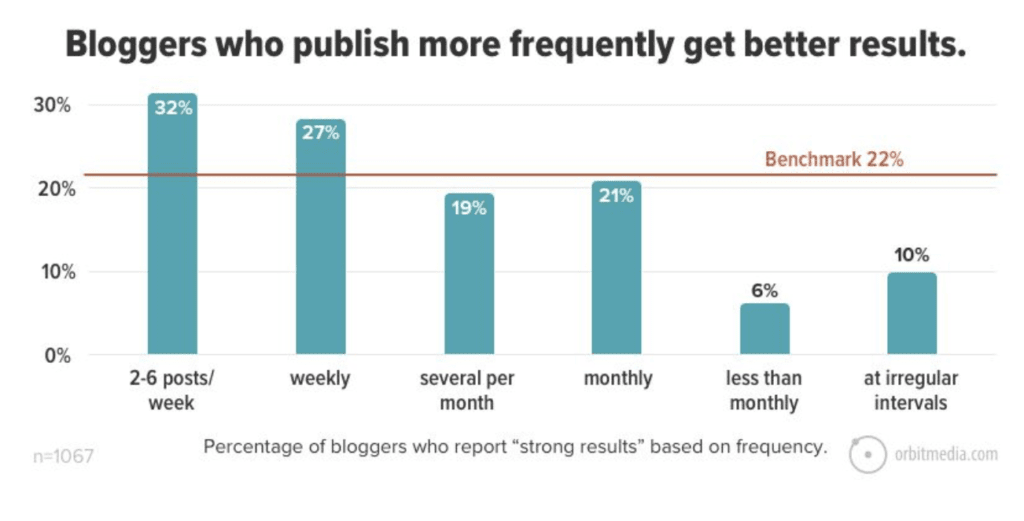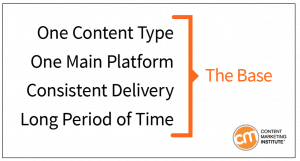
Best times to schedule and publish content marketing?
In our content marketing workshops, marketers from GlaxoSmithKline and US Cellular raised questions about the best times to schedule and publish content marketing:
Q. “How did you determine the best content frequency for your audience?”
Q. “Based on the platform (YouTube, website, Twitter, etc.), what is the appropriate schedule of content to push out to keep consumers engaged? What are best practices for each of these platforms when it comes to publishing schedules?”
A. I wish there were really simple answers for these tough questions. But the truth is, there aren’t.
That’s because these questions are deeply particular to your business and your customers’ information habits. Ultimately, your followers’ and customers’ behaviors determine what’s the best frequency for your content.
One frequency does not fit all
When it comes to optimal publishing times, the answer is different for each brand.
Why?
- Since your customers are different from other brands’ customers, the best publishing schedules differ too. You can’t just copy someone else’s schedule, because their buyers won’t behave the same ways that your buyers do.
- You have limited resources for publishing. If you had infinite resources, the best schedule would be to publish one or more posts daily. But in the real world, you’ll need to balance the available resources with the audiences’ needs.
High-frequency content succeeds more often
Frequency is one of the big issues for bloggers.
Since 2014, Andy Crestodina of Orbit Media has surveyed marketers about blogs. Here’s what he’s learned about how much effort goes into blogs, and how publishing frequency correlates with success.

Everyone would like to blog more, but here’s the catch. Each year, it takes more and more time for marketers to publish and promote each blog, the same survey showed.
Great blogs take 6 hours or more

Marketers need to strike a delicate balance between publishing frequency and available resources. That’s the dilemma marketers face as we choose the frequency.
3 steps to find your optimal schedule
Here’s how to find the best times to schedule and publish content marketing.
As you set your editorial schedule, keep your eye on developing 3 good content habits:
1.) Make and keep an appointment with your readers.
2.) Find a sustainable cadence for content that you can maintain.
3.) Use analytics and other tools to optimize your posting schedule.
1.) Make and keep a date with your readers.
To make an appointment with readers, you need to know where they are and when they go there. When do your buyers look for relevant content, on which kind of device, and on which websites, news, or social media?
Choose the times and places that work best for your readers, buyers, prospects, and customers.
Start with input from your buyer persona research.
Add other customer research and analytics you have available.
Find out what triggers buyers
Ask questions that help you identify buyers’ trigger points, so you can see how the buyers’ triggers relate to the calendar and clock. For example:
• Do customers buy based on a technology refresh cycle?
For example, cell phone buyers may delay buying until a new generation comes out – then decide.
• Can triggers prompt buyers to act at a certain time on the calendar or clock?
Many people start to buy Christmas gifts right after Thanksgiving — but in the pandemic, people may need to complete Christmas shopping in October. On the other hand, technology buyers may kick the tires on a new product at a trade show, then decide a few months after the show.
• Are prospects more likely to research or buy your product on certain days or at certain times of the day?
For example, people search for coffee shops in the morning, and for sleep remedies in the evening.
• Do weather-related triggers matter?
Campbell Soup runs more ads when the weather turns cold because that’s when people crave soup.
Learn from buyer persona research
As you do buyer persona research, ask broadly about your buyers’ information habits:
• Do your buyers read the news in the morning? On paper, or online?
• Will your buyers watch TV in the evening? Do they also use multiple screens – a tablet, a smartphone?
• Can your buyers read social media and email during the day – on a PC or on a mobile device?
• Do your buyers commute by car – and listen to the radio or pass by certain billboards each day? Do they travel by train or bus, where they regularly see the content and ads in the station?
Answers to these questions will lead you to find the best times to schedule and publish content marketing.
Remember that buyers are habitual – they go where they always go for information.
It’s easier to meet them where they are in their usual haunts, rather than to try to move them to a place and time of your choosing.
Where do buyers go for info?
Buyers probably don’t go to your website for information first – instead, they use voice or web search, news media, e-commerce sites, or social media. What content will they find when they get there? Will yours pop up a the time when they need it?
Find out all you can about what buyers search for, their exact search terms, and the times of day they’re likeliest to search.
Remember, your buyers differ from other brands’ buyers, so don’t accept others’ findings at face value.
Every day, 3 billion searches happen on Google. About 20% of the questions asked are new!
A good tool to find out which long-tail questions your buyers today are asking today is answerthepublic.com.
Your email analytics may tell you if you are publishing too often or too infrequently. Pay attention and stay inside the guard rails:
• If you publish too infrequently, you may have a hard time attracting subscribers to your email. When readers don’t know how often your content will come, they’re much likelier to ignore it and less likely to subscribe.
• If you publish too often, you may see lower open rates and click-through rates. The number of emails unsubscribes will rise. People may choose “publish too frequently” as the reason they unsubscribed.
Make and keep a date with readers
Make an appointment with your readers, and keep it religiously.
For example, we have published this blog every Wednesday since 2014. People share it most on Wednesdays when our emails go out.
Do you know on which days of the week your content performs best? Find out when your readers are most active, so you can deliver content when they’re engaged and likely to interact with it.
2. Find a sustainable cadence for content, and maintain it.

Find a pace for content creation that you can sustain forever. To prove you can sustain it forever, sketch out a content editorial calendar for the next 12 months.
If you find that you can’t populate a year’s worth of content ideas on an editorial calendar, you’re probably spreading yourself and your content too thin.
The most successful piece of content marketing ever is The Guinness Book of World’s Records, published annually for decades. That’s the cadence its audience expects.

Put quality first, frequency second
Be smart. Publish fantastic content infrequently rather than publishing mediocre content too often.
Focus on consistency and quality first – frequency second. Set a pace that you can keep consistently, while always maintaining the highest quality of content.
Is there a yearly rhythm to your business?
The marketers at See’s Candies in San Francisco have identified 18 holidays that trigger chocolate buying. They gear their content around these holidays, which are chocolate-buying events.
Can you find a similar rhythm to the year in your business?
Content marketing is always a marathon, not a sprint. It’s a long game — perhaps forever.
When you start up a new content venture, it’s tempting for marketers to use all your best content ideas right as you come out of the gate. Don’t fall into that trap!
The problem: after a great initial launch, two or three months later your content cupboard lies bare. Worse, you’ve now set higher expectations with your audience – who expects you to keep up the pace you may not be able to sustain.
Questions to ask as you decide
Andy Crestodina at Orbit Media wisely advises considering certain questions when you decide on a blog publishing schedule:
• How long is your sales cycle? Some sales happen in a flash. But in B2B, equipment sales can take 6 to 24 months from start to finish.
• How long is your buying interval? Do people buy your product once a year, twice a year, once a week? To stay top of mind, publish more frequently than the typical buying interval.
• What fits with your marketing and business goals? Does publishing frequency depend on exactly what you’re trying to achieve: awareness, consideration, lead generation, sales?
Set minimum goals, then commit to meet them ALWAYS.
For example, you may decide to:
• Tweet 4 times a day.
• Update LinkedIn twice a day.
• Update Facebook and Instagram daily.
• Blog once a week.
• Send an email once a week.
• Produce a new video every two months.
• Publish your magazine once a quarter.
Do you need to implement these many tactics? No, you don’t!
As the Content Marketing Institute (CMI) advises, it’s best to start building one platform, make it as strong as you can, then expand out from your first success. Start here with your content base:

Many marketers are simplifying their content marketing. A few years back, marketers used an average of 12 tactics, but now many use one-third fewer. They’ve wisely chosen a pace they can sustain.
It’s smart to focus on a few tactics that work well, rather than too many tactics implemented unevenly.
Capture your content cadence in a calendar. Whatever your schedule you set, once it’s set, maintain that frequency. Keep your date with your customers.
Tools can help you succeed
3. Use tools to help optimize your schedule.
For example, we’ve used a tool called Buffer to solve the problem of what time of day to post on social media.
Based on the behaviors of people in our networks, Buffer automatically chooses the optimal times of day to post, for example:
• 4 times a day on Twitter, at 8:50 a.m., 10:09 a.m., 12:28 p.m., and 4:09 p.m.
• Twice a day on LinkedIn, at 8:48 a.m. and 6:21 p.m.
Buffer and similar tools enable you to identify the best times of day to post based on your unique network. By the way, these optimal times drift and shift over the months, so you may need to update them frequently.
Use your analytics tools to find out more about when to reach your audience.
For example, ask:
• What time are your emails most read? Does higher email performance correlate with a certain day of the week or a certain time of the day?
• When are your posts shared the most?
• What posts are most popular, most shared, most read, and most liked?
• Which pages and posts lead to conversions?
• If people don’t find the next thing they need, from which page do they abandon the website?
All of these data will give you crucial clues about the best times to schedule.
Apply all-in analytics
Use all-in analytics to learn what you need to know about frequency:
- Gather all your analytics into one place.
- Invite your team to review them with you.
- Hypothesize individually about what is driving the trends.
- Get together to discuss your competing hypotheses.
- Test hypotheses by doing A/B tests, quick course changes, experiments, and maneuvers to find out what works best.
Apply analytics to help you solve the problem of when and where to find your audience. Ultimately, your followers’ and customers’ behaviors determine what’s the best frequency for your content.





